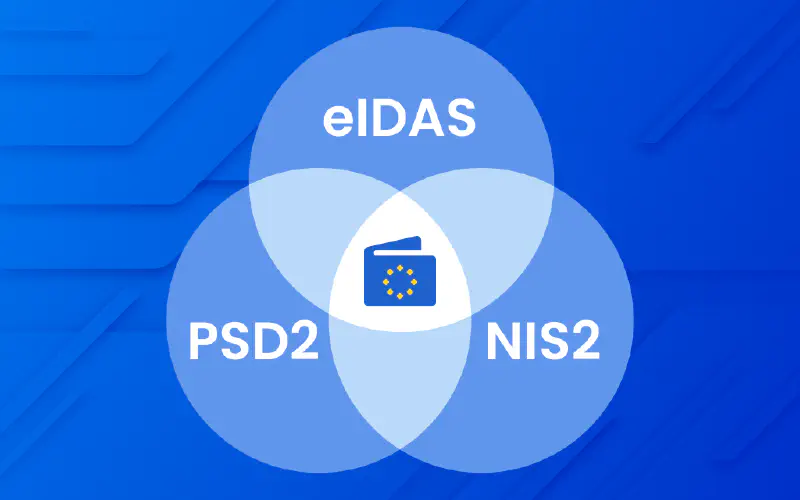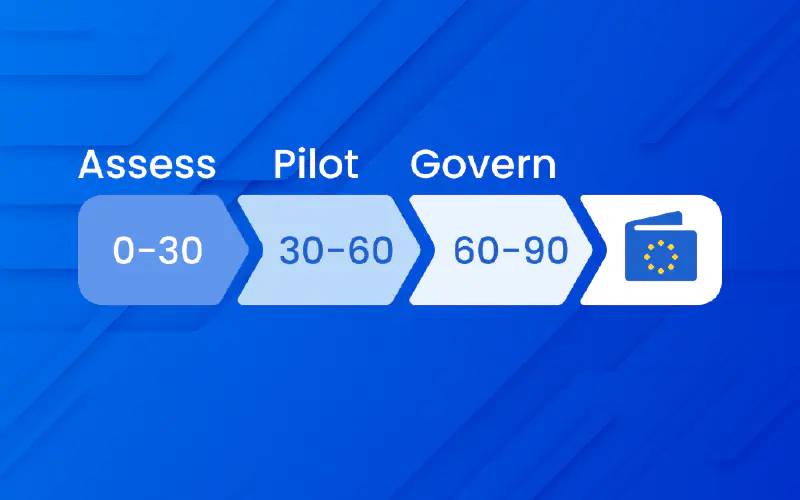EUDI Wallet Acceptance for Enterprise IAM (2025–2027): A 90-Day Blueprint
November 6, 2025 by Nick Morgan

EUDI Wallets and the Enterprise IAM Landscape in 2025–2027
EUDI Wallets are state-backed digital identity wallets defined under eIDAS 2.0 to let users authenticate, assert attributes, and sign with high assurance across borders, with each EU member state required to provide at least one wallet by 2026 for broad public and private sector use. These wallets are guided by the EU Architecture and Reference Framework to ensure interoperable, secure implementations that enterprises can integrate into login, KYC, and signature flows across the Single Market. For enterprises, the emergence of EUDI Wallets means preparing IdP/SSO stacks to accept wallet-based verifiable presentations and signatures while aligning with trust service and assurance levels recognized across the EU.
Enterprises should act now because eIDAS 2.0 is already in force, member states are progressing through implementing acts, and wallets must be available by 2026 with broad adoption phases through 2027, creating near-term integration pressures and first-mover opportunities. NIS2 simultaneously tightens security expectations around access control, MFA, incident reporting, and vendor oversight in 2025, raising the bar for IAM controls that wallet-based authentication can help meet. Payments and account access journeys also remain bound by PSD2 SCA, where wallet-based strong authentication can streamline step-up while meeting regulatory expectations on multi-factor and dynamic linking when used in payment contexts.
This part focuses on buyer actions: how to implement wallet acceptance in enterprise IAM, where to begin with pilots and KPIs, and which platform capabilities to prioritize when evaluating IdP/SSO vendors and integrators. The scope is commercial and transactional: mapping eIDAS 2.0 to your IdP/SSO, selecting vendors with verifiable credential support, and defining procurement and rollout governance to hit the 2026–2027 window. Navigation-wise, the emphasis is on concrete integration patterns, RFP criteria, and ecosystem alignment including QTSPs for qualified signatures and ARF-aligned wallet flows.
Understanding EUDI Wallet Requirements for Enterprise IAM
Key Requirements: eIDAS 2.0, Selective Disclosure, and Verifiable Credentials
eIDAS 2.0 expands the original framework to mandate a European Digital Identity Wallet that works across public and private services, with implementing acts and national programs driving technical conformity and interoperability that enterprises will need to accept in access flows. The 2026 delivery milestone for at least one wallet per member state means enterprises should plan procurement and technical mapping in 2025 to avoid bottlenecks in regulated user journeys by 2026–2027. Relying parties should expect harmonized assurance and trust services, with legal validity for qualified signatures and cross-border recognition that affects contract workflows and account openings.
Selective disclosure is central: wallets must enable users to share only necessary attributes, such as proof-of-age or sectoral credentials, reducing data exposure in enterprise authorization and KYC flows. Standards support includes SD-JWT and cryptosuites such as BBS+ or ECDSA-SD to derive minimal proofs from source credentials, preserving privacy while maintaining verifiability. For enterprises, this means authorization policies and attribute mapping must anticipate partial attribute releases rather than full identity disclosures, which affects claims processing in IdP/SSO and downstream apps.
Verifiable credential support becomes a vendor must-have: IdP/SSO platforms need to process verifiable presentations aligned with the ARF and VC Data Model v2.0, and interoperate with wallets and trust service providers for issuance and verification where required. Procurement should evaluate support for OpenID-based wallet flows and verification policies consistent with eIDAS 2.0 assurance and trust services, including integration paths to QTSPs for qualified signatures. WWPass enterprise SSO and passwordless capabilities demonstrate how vendors can combine phishing-resistant authenticators with standards-based federation to prepare for wallet-enabled flows at scale.
Commercial Use Cases & ROI: Why Move Forward
Business Value of EUDI Wallet Adoption for Enterprises
Compliance is the first ROI driver: aligning IAM with eIDAS 2.0 timelines reduces regulatory risk in identity assurance, signatures, and cross-border access, smoothing audits and contractual obligations. NIS2 strengthens expectations for MFA, access control, and vendor risk management, making wallet-based strong authentication and verifiable attributes an effective way to meet control depth while minimizing data retention. Operationally, passwordless SSO with phishing-resistant authenticators reduces helpdesk tickets and credential risk, which translates into measurable cost savings and higher completion rates in critical journeys.
High-impact IAM scenarios include customer onboarding with wallet-based KYC attribute sharing to reduce friction and avoid sensitive data over-collection in regulated sectors. Workforce and partner SSO can use wallet-derived attributes or strong authentication to gate high-risk apps, satisfying internal policies and NIS2-aligned MFA requirements with phishing resistance. Payment and account-access flows can map wallet-derived SCA to PSD2 requirements, improving authorization rates while maintaining two-factor alignment for qualifying transactions.
Vendor and partner ecosystems become essential: integrators and IdP vendors should offer managed deployment patterns, federation templates, and verifiable credential verification at scale with clear SLAs. WWPass demonstrates practical enterprise integrations where passwordless SSO and strong authentication are combined with SAML/OIDC federation for common business apps, illustrating how to operationalize wallet-ready access tiers. Selecting partners with QTSP relationships and ARF-aligned testing reduces go-live risk for qualified signatures and cross-border acceptance.
Navigating Legal and Regulatory Obligations
eIDAS 2.0, PSD2 SCA, and NIS2: Enterprise Key Actions

eIDAS 2.0 governs the wallet’s legal framework, trust services (including qualified signatures), and cross-border recognition, setting the structure for enterprise acceptance and verifiable presentations. PSD2 mandates Strong Customer Authentication for online payments and certain account-access scenarios, which can be met with wallet-based multi-factor methods that align with recognized categories. NIS2 elevates cybersecurity risk management, incident reporting, and access control, reinforcing enterprise expectations for MFA, encryption, and vendor oversight across sectors.
Key deadlines include eIDAS 2.0 in force since May 2024, with wallets due by 2026 and extended sectoral ramp-up toward 2027 in many roadmaps, driving procurement and pilot timelines today. NIS2 transposition and enforcement across 2024–2025 have expanded scope and accountability, making 2025 the year to demonstrate MFA and access control improvements aligned with enterprise risk appetites. PSD2 SCA requirements remain active and clarified by regulators for digital wallet contexts, emphasizing two-factor and dynamic linking in payment initiation.
Commercial procurement should require ARF-aligned wallet acceptance, VC Data Model v2.0 support, and selective disclosure capabilities with SD-JWT or equivalent cryptosuites. Contracts should address QTSP integrations for qualified signatures, data minimization with selective disclosure, and audit-ready verification logs for regulators and auditors. Vendor evaluations should include proven passwordless SSO, phishing-resistant authenticators, and enterprise federation patterns to reduce delivery risk and accelerate time-to-value.
90-Day Blueprint: Implementation Roadmap

Phase 1 (Days 1–30): Preparing Your IAM for EUDI Wallet Acceptance
Assess IdP/SSO readiness by cataloging federation protocols (OIDC/SAML), phishing-resistant authenticators (FIDO2/WebAuthn), and attribute mapping layers to accept verifiable presentations aligned with the ARF. Validate passwordless and strong authentication baselines to meet NIS2-aligned MFA expectations and to pave the way for wallet-based SCA in payment or high-risk account flows. If your current stack lacks passkey-grade phishing resistance or flexible claims processing, shortlist vendors with demonstrable enterprise rollouts and migration playbooks.
Set pilot goals and compliance KPIs that map to regulatory outcomes: wallet login success rate, selective disclosure acceptance for minimal attributes, time-to-verify, and audit log completeness for verification events. For payment or account-access pilots, include PSD2 SCA alignment metrics such as step-up completion, exemption coverage where applicable, and fraud/chargeback trends post-wallet adoption. For NIS2, define control-maturity checkpoints across MFA coverage, incident reporting telemetry from the IdP, and vendor oversight artifacts tied to wallet integrations.
Prioritize high-impact transactional flows where acceptance reduces friction or regulatory exposure: customer onboarding, high-value account changes, payments authorization, and vendor/partner access to sensitive portals. Target sectors and journeys with 2026 exposure under eIDAS 2.0 and extended adoption to 2027, ensuring you can demonstrate wallet acceptance and verifiable attribute handling for critical services. Leverage vendor ecosystems to accelerate integrations, using proven templates for SSO, MFA, and verifiable credential verification to get pilots live within 30 days on a constrained scope.
Phase 2 (Days 31–60): Piloting and Metrics for EUDI Wallet Integration
Partner and vendor coordination begins on day 31 by confirming your integrator’s readiness to deploy wallet acceptance within your IdP. Verify that your chosen partner, whether an OIDC/SAML federation provider, a managed identity service, or a specialized EUDI Wallet integration firm, has documented OpenID for Verifiable Credentials (OID4VC) support and live reference deployments demonstrating proof-of-concept (PoC) in at least one member state. Request their test environment credentials, conformance test results aligned with the eIDAS 2.0 Architecture Reference Framework (ARF), and an onboarding schedule that maps to your 60-day checkpoint. Assign a cross-functional pilot team including IdP owners, application architects, compliance liaisons, and key user representatives to oversee integration, testing, and feedback cycles.
Configuring your IAM for verifiable credential exchange requires updating your IdP’s claims and attribute mappers to process incoming wallet presentations and selective disclosures. If using Microsoft Entra ID or Okta, familiarize your team with their OIDC/SAML federation settings to accept verifiable presentations from conformant EUDI Wallet implementations. For each pilot transaction, customer onboarding, workforce SSO, or payment authorization, define which attributes you’ll request from the wallet (e.g., proof-of-age, legal entity status) and map them to your app authorization policies. Enable SD-JWT (Selective Disclosure JWT) or equivalent cryptosuites at the IdP to verify that wallets are only disclosing the minimum required attributes, reducing your stored PII footprint. Configure audit logging at the IdP to capture every verification event, including wallet entity ID, presented claims, timestamp, and access decision, creating an immutable record for regulatory review.
Testing verifiable credential issuance and presentation workflows should replicate real enterprise scenarios. If your pilot includes external relying parties (partners, payment processors), test OpenID for Verifiable Credentials flows using sandbox wallets provided by eIDAS 2.0 implementation teams or Large-Scale Pilot (LSP) ecosystems. Use WWPass’s passwordless SSO capabilities to layer phishing-resistant authentication above wallet-derived attributes, ensuring that users authenticate with FIDO2/passkeys or equivalent before any sensitive transaction completes.
Measuring pilot success depends on defining KPIs aligned with business and regulatory outcomes. Track transaction authorization rates, the percentage of user requests where wallet-based credentials are accepted and processed without fallback, targeting at least 85–90% completion within 14 days. Monitor SCA satisfaction by measuring the percentage of users who complete Strong Customer Authentication via wallet-based methods without friction, aiming for >80% successful SCA without repetition. In payment scenarios, evaluate fraud signal improvement: compare transaction decline rates pre- and post-wallet integration, expecting a reduction in false positives because wallet-derived attributes and strong authentication raise assurance.
Collect user journey improvement metrics: conversion rate (% of users reaching transaction completion), time-to-authorize (seconds from wallet trigger to approval), and abandonment rate (users who drop mid-flow). Benchmark these against your legacy SSO or password-based baseline, targeting at least 15–20% improvement in conversion and 30% reduction in abandonment. Measure attribute accuracy and data minimization: log the number of attributes requested vs. disclosed by the wallet, and verify that selective disclosure is actually reducing data transfers.
Audit trail completeness is critical: track the percentage of verification events logged and queryable within 24 hours, targeting 100% compliance. For compliance and incident response, measure log integrity, the number of unauthorized log modifications, maintaining zero tolerance via immutable storage. Collect helpdesk and support metrics: count of calls related to wallet login, recovery, or attributes to quantify operational impact and identify training gaps.
Run a pilot cohort analysis by segmenting users, IT staff, pilot departments, customer segments, and tracking KPIs per group to identify high-friction persona. Conduct weekly retrospectives with your vendor partner and pilot team, reviewing KPI trends, user feedback, and integration issues. Document pilot results in a formal report by day 55–60 to decide whether to proceed with rollout, extend pilots, or address critical gaps.[
Phase 3 (Days 61–90): Scaling for Enterprise Rollout and Governance
Drafting audit trail and governance structures starts with formalizing policies that specify how wallet verifications, claims processing, and authorization decisions are logged, retained, and reviewed. Define a retention schedule: wallet verification events should be retained for a minimum of 3–7 years to satisfy eIDAS 2.0 audit expectations and regulatory inquiries. Establish role-based access controls (RBAC) for audit log viewing: security teams, compliance officers, and internal auditors can review logs; IT operations can monitor real-time events; developers can query logs for debugging.
Create a governance committee composed of IdP owners, security leads, compliance liaisons, and legal representatives to oversee wallet rollout, policy updates, and regulatory alignment. The committee should meet bi-weekly to review compliance KPIs (e.g., SSO success rate, SCA completion, log integrity), address incidents, and recommend operational improvements. Document traceability standards: every wallet login and attribute disclosure must be traceable to a user, transaction, and service; include proof of selective disclosure and signature verification in logs.
Commercial rollout planning requires internal and external training aligned with user roles. Create training modules for IT staff on wallet integration workflows, password hygiene, and SSO federation. Develop customer-facing guides explaining how to enroll in the wallet, set up biometric/PIN, use it for login, and recover if lost, using plain language and screenshots. For high-risk services (payments, account changes), implement role-based capability enablement: ensure payment teams and compliance staff understand how wallet-derived SCA differs from legacy 3D Secure or SMS OTP, and what to monitor for fraud signals.
Establish support and escalation paths: designate a wallet support team, define tier 1 (user enrollment, device recovery) and tier 2 (integration issues, signature verification failures) handoffs, and set response targets (e.g., tier 1: <24 hours; tier 2: <48 hours). Prepare regulatory communications: draft notifications to payment processors, banking partners, and compliance auditors explaining your wallet acceptance, attribute handling, and audit trail capabilities.
Ensuring ongoing NIS2 and PSD2 compliance post-deployment requires aligning wallet access controls with NIS2’s mandatory MFA, encryption, and vendor oversight. Map wallet-derived attributes and SCA to NIS2 control requirements: wallets provide phishing-resistant MFA (satisfying MFA mandates), selective disclosure reduces data exposure (supporting data minimization), and audit trails enable incident reporting. Schedule annual compliance reviews with your IdP vendor and QTSP partners to confirm they maintain eIDAS 2.0 conformity, NIS2 security posture, and PSD2 SCA alignment.
Choosing the Right EUDI Wallet Solution

Selection Criteria, Vendor Comparison & Integration Patterns
Evaluate vendors on commercial terms and deployment models: licensing fees (per user, per transaction, or monthly subscription), managed service vs. self-hosted options, and support SLAs. Request proof of OIDC and SAML compliance with explicit support for OpenID for Verifiable Credentials, verifiable credential verification, and selective disclosure. Confirm the vendor’s NIS2 and PSD2 readiness by reviewing their security audit reports, incident response procedures, and compliance certifications (ISO 27001, SOC 2).
Compare integration ease with your IdP: does the vendor provide pre-built connectors for Microsoft Entra, Okta, or Ping Identity, or will you custom-develop? Check reference customers who have deployed passwordless SSO, wallet acceptance, and multi-protocol federation. For payment scenarios, confirm that the vendor’s SCA implementation aligns with PSD2 requirements and supports dynamic linking where applicable.
Navigational advice for RFP teams: structure your procurement by first defining your pilot scope (3–5 apps, 50–200 users), then asking vendors to provide cost estimates for that scope with clear pricing transparency. Include contractual clauses requiring vendors to maintain audit trail integrity, support NIS2 compliance, and comply with QTSP relationships for qualified signatures if needed. Request a comprehensive demo environment where your team can test wallet enrollment, SSO, attribute disclosure, and audit log export before contract signature.
For SSO and passwordless authentication capabilities, evaluate vendors like WWPass that combine phishing-resistant FIDO2 support with seamless OIDC/SAML federation, reducing your go-live timeline and integration complexity. Confirm that your vendor supports cross-platform coverage (Windows, macOS, iOS, Android) and offers recovery mechanisms (backup keys, admin-assisted recovery) that your support team can operationalize.